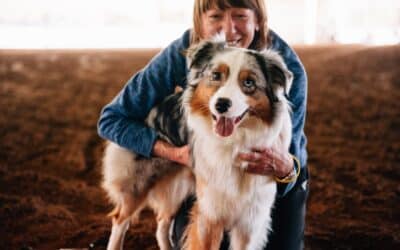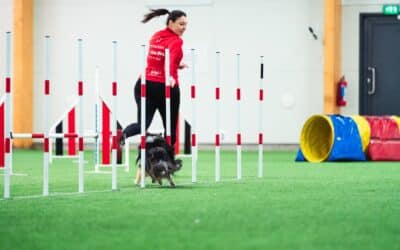We’ve all been there: working with our dogs, things are going well, and that last rep was oh so close. Our brain says, “Just one more time,” hoping to achieve perfection. But does perfection really exist?
OneMind Dogs Instructor Laurie Huston would argue that it doesn’t. In this article, Laurie shares her views on the importance of planning your training sessions.
There will always be something we want to improve. That’s part of what keeps us coming back: the desire to grow, learn, and improve. We attend classes and seminars to enhance our skills with guidance from trusted trainers. Then, we head out to train on our own and sometimes get caught up in the hope that one more try will get it right.
More often than not, that last attempt doesn’t go as planned, and it may even end worse than the previous rep. This can lead to a spiral, trying to recreate that oh so close moment, resulting in longer sessions than intended. This spiral creates frustration for both ends of the leash. Humans may feel frustrated by the lack of progress, while dogs, unsure how to succeed, experience frustration as well. Dogs express frustration differently—some may get overly excited, while others may withdraw, disengage, or even opt out completely. It’s a no-win situation for both of you!
Research shows that dogs learn more effectively—and retain knowledge better—when we focus on less: shorter sessions, fewer reps, and more targeted training. So how can we avoid the pitfalls of overtraining? The answer is simple: planning.
Creating an Agility training plan with OneMind Dogs
If you’re looking for help creating an effective training plan for dog agility, OneMind Dogs is here to support you every step of the way. Agility Premium members have exclusive access to experienced coaches who can guide them in designing a personalized plan tailored to their dog’s needs and goals. Whether you’re troubleshooting specific challenges or working on foundational skills, the OneMind Dogs team can help you create clear, consistent, and achievable training sessions. Planning becomes even more efficient when you have expert advice and feedback to set you and your dog up for success.
The Importance of Planning
Proper planning can help:
- Ensure training sessions run smoothly
- Increase skill fluency
- Reduce frustration for both dog and handler
- Transfer trained behaviors into trial skills
- Increase efficiency
- Enhance enjoyment for both you and your dog
- Maximize the use of your available time
For me, the key components of planning focus on Clarity, Consistency, and Connection. Let’s break these down:
- Clarity: Clear expectations reduce frustration for both you and your dog. When you’re clear about what you want, your dog understands how to respond appropriately.
- Consistency: Consistency reduces stress and makes your training predictable. Repetition helps reinforce the clarity of your expectations.
- Connection: A strong connection allows you to actively support your dog as a teammate. When you’re connected, communication flows more easily, improving the learning experience.
By planning ahead, you increase clarity and consistency, which helps build a stronger connection.
Planning for Errors
Errors are inevitable, and how you respond to them can greatly influence your session. Thinking through potential responses in advance helps you react seamlessly in the moment. The hardest thing for dogs is a delayed response from us—nothing says “nope, that’s not it” more clearly than silence or confusion.
Consider these questions:
- How many errors are acceptable? Decide in advance how many mistakes you’ll allow before adjusting your approach.
- How will you adjust? If multiple errors occur, have a plan to break the behavior into smaller, more achievable steps. Reinforcement is key to building success.
Sometimes, despite your best planning, things won’t go as expected. When that happens, ending the session is often the best choice. Many times, when you revisit the behavior later, it’s successful because the timing or circumstances have changed. Contributing factors may be our mental state, our dog’s mental state or an environmental factor we didn’t recognize. All of these things make ending the current session a positive choice. It gives you the opportunity to do something enjoyable, like taking a relaxing walk or playing a fun game of tug. Allowing you to end on a positive note, even though it is unrelated to your original goal, this helps to maintain your dog’s enthusiasm and confidence.
Managing Reps and Session Duration
One of the most important factors in avoiding overtraining is tracking the number of reps or the session duration. I prefer setting a defined number of reps rather than relying on a timer. This approach works well because I often take breaks during sessions for play or rest. Setting limits keeps my sessions productive and prevents overtraining.
Remember: less is more. Short, focused sessions are more effective than long, drawn-out ones. Learn more in this video.
Planning for Success: Take Notes
During classes and seminars, it’s easy to think you’ll remember everything, but details often slip away. Take detailed notes on setups, environments, surfaces, instructor feedback, and other relevant information. Drawing maps of exercises can also help you replicate them during training. These notes will guide future training sessions and troubleshooting.
Journaling Your Training Sessions
Journaling is an invaluable tool for tracking progress. Record what went well, areas for improvement, and other factors that influenced the session, such as the environment, location, weather, rewards, or distractions. Journals help you spot patterns, identify areas for growth, and plan effectively for the future.
Above All, Have Fun!
The most important aspect of training is enjoying the journey with your dog. If you’re not having fun, take a step back, reevaluate, and make adjustments to bring joy back into your training.
Stay tuned for Part 2, where we’ll dive deeper into planning strategies!



